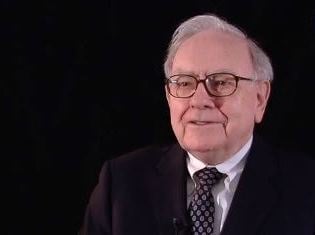Warren Buffett is generally considered to be one of the great investors of modern history. After all, under his leadership, Berkshire Hathaway Inc. (NYSE: BRK-A) has become worth more than $300 billion, putting Buffett’s own net worth at more than $60 billion. Source: courtesy of WhiteHouse.gov
Source: courtesy of WhiteHouse.gov
Many investors chase Buffett’s stock investments each quarter, and there are numerous lessons that can be picked learned by understanding the Oracle of Omaha’s investment career. While you almost certainly will not be out striking a multi-billion dollar buyout of a railway, utility or food company, there are many relatable lessons in Buffett’s investment strategies.
Based on our own analysis, 24/7 Wall St. has identified 10 strategies that help ordinary speculators invest like Buffett. These strategies do not focus on chasing Buffett’s moves after he has made them. Instead, the aim of these strategies is to encourage a strategic approach to long-term wealth-building strategies, and to help you adapt as the the market evolves throughout your life.
Buffett thinks longer term than the bulk of investors. He also keeps his approach relatively straightforward and has formulas for what he thinks works. Buffett knows a few things about the business cycle of booms and busts. It is not by accident that the companies he picks do not go belly up in hard times.
Buffett also considers industry trends over a period of decades. His holding period is similarly long. You will see references to The Coca-Cola Company (NYSE: KO), American Express Co. (NYSE: AXP), Wells Fargo & Co. (NYSE: WFC), International Business Machines Corp. (NYSE: IBM) and others throughout. Buffett has been a long-term investor in all of these companies.These four positions were 56% of the total fair value of his $116 billion in public equity holdings as of March 31, 2014.
Analyzing Warren Buffett is often harder than it seems. While Buffett is no stranger to talking up his own portfolio, he only speaks with the media when he wants to. And now he has two portfolio managers under him, not including his long-time friend and Berkshire vice chairman, Charlie Munger. Simply chasing new Warren Buffett stock picks is something guru-watchers often do. However, there is a long lag between when Buffett invests in a company and when the public gets to see the new holding in SEC filings.
Here are 10 strategies that all investors can use to invest like Warren Buffett.
1) Sticking With What You Know and Can Easily Understand
The next hot biotech or technology stock is too obscure for Buffett — and he is a billionaire a few dozen times over. Buffett’s success has been largely tied to sticking with what he knows. His main operations are insurance, industrials, utilities, and rails. His top stock holdings are familiar companies for many Americans as well — American Express, Coca-Cola, Wells Fargo, and IBM. Many of his private companies also operate along straightforward business models, including Heinz, GEICO, Fruit of the Loom, Netjets, and a dozen or more jewelry, furniture, and retail outlets.
Apply that to your own investing and focus on products you use and companies you can easily value. Investing in companies connected to your own profession is another way of sticking to what you know.
2) Having a Forever Outlook
Buffett once said that his ideal holding period was forever. As a reminder, Buffett first invested in Coca-Cola in 1988 and has never sold any stock. Buffett has also held onto American Express through thick and thin for years. Buffett first bought American Express shares so long ago, and at such a low price, that the company’s current low dividend is actually quite high for him on a cost basis. Thinking like a futurist has helped Buffett’s investing endeavors. Patiently waiting for industry trends to play out over a decade or two is a key component of a Buffett investment.
3) Investing in Value, at the Right Price
Warren Buffett believes in value investing and is a student of the valuation techniques pioneered by the great Benjamin Graham. Buffett typically screens for companies that have low debt, offer a strong return on equity, and have a favorable price to earnings ratio. A clean balance sheet is, of course, a must. Also, Buffett may not ever pay a dividend to his Berkshire Hathaway shareholders, but he loves investing in companies that offer dividends and buybacks. These investments can lower your cost basis or help you build cash for other opportunities ahead.
That said, Buffett has tweaked his approach over the years. For for the longest time he would not chase technology stocks or companies. They changed too fast, had short track records, and carried expensive valuations. Buffett broke this pattern when he amassed a major stake in IBM in recent times. Still, he never chases “the next home run,” such as 3D printing, social media or biotech.
4) Only Investing in Solid Management and Clean Books
Buffett does not invest in risky turnaround situations or, in untested management. He sticks with proven winners. Even when he buys a company outright, he prefers to broker deals in which management stays in place. You can be sure that Buffett does not chase after companies with questionable accounting practices, even if they look cheap to other investors.
Buffett once said, “It takes 20 years to build a reputation and five minutes to ruin it. If you think about that, you’ll do things differently.” Doing things differently, for Buffett, means avoiding companies where management has poor ethics or skeletons in the closet.
5) Understanding Timing, Picking Extremes
Buffett generally takes the long-term approach but, during the Great Recession, he noted that it is important to “be fearful when others are greedy, and be greedy when others are fearful.” During financial meltdowns, this means investing heavily when the market has been crushed and when the media and public are at an inflection point. Buffett has a proven track record of intervening in companies hit by recession, including Bank of America, Goldman Sachs, General Electric, and Dow Chemical.
6) Knowing When and How to Keep Buying on the Cheap
The common investor does not get to bet on the markets through custom, multi-decade derivatives investments, but there are ways for mom-and-pop stock pickers to buy in on the cheap. In the past, Buffett has reportedly sold put options that are considered slightly out-of-the-money in stocks he wants to acquire. While this gives him the obligation to buy more shares if the price dips, he receives a premium from selling the put options to lower his cost basis. Another tip is to just keep slowly acquiring shares regularly over time. For example, Buffett has consistently bought shares of Wells Fargo since the recession, adding gradually to the position rather than piling in all at once.
7) Keeping Your Powder Dry, and Keeping Reserve Funds
You might not get to have a portfolio with 100 positions in it, and you might not have a couple dozen subsidiaries to manage, but one thing you can do is follow the same mantra as Buffett of keeping cash reserves. His reserves are almost certainly much larger than yours. Still, even if you have daily business operations to fund and lots of passive investments, you will do extremely well to maintain cash reserves. Such reserves allow investors and businesses to pursue opportunities that are too good to pass up on, and they also provide a cushion from unexpected events. This is perhaps one of the greatest lessons that Buffett seems to always include in his annual reports.
8) Knowing When You Made a Mistake… or When Times Have Changed
Sometimes mistakes happen. Buffett has joked about how he wished he had never sold his huge stake in Walt Disney. He also made a mistake trusting that protege David Sokol would act solely in Team Buffett’s best interests when he got to review potential acquisitions and other deals. Sokol resigned after failing to disclose a stake in special chemical company Lubrizol, which he built-up shortly before recommending the company to Berkshire Hathaway as a potential acquisition. Sokol had previously been considered by outsiders as a key part of the Buffett succession plan. Buffett did not let one blemish get in the way of his business decision and he still went ahead and closed on the Lubrizol acquisition.
Berkshire Hathaway once had a stake worth billions in Procter & Gamble, acquired through the P&G’s merger with Gillette. But Buffett sensed that times had changed and finally decided to unload P&G.
9) Looking Internationally
Almost everyone thinks that Buffett only toots the horn of American equities and only invests in conservative companies. While this is generally true, Buffett has made investments further afield, such as in Chinese electric car maker BYD. He also invested heavily in ISCAR, an Israeli metalworking company. Buffett and his team invested heavily in Suncor in Canada, as a play on Canadian oil sands — and maybe as a hedge against BNSF and the potential Keystone Pipeline. Prior managers under Buffett also invested in foreign drug makers Sanofi-Aventis and GlaxoSmithKline.
When it comes to international themes, investors can focus on large American companies that have a presence abroad and that stand to benefit from the rest of the world catching up to the U.S. in the coming century.
10) Maximizing Your Tax Strategy
One easy-to-recognize reason that Warren Buffett holds onto stocks for so long is because of the tax implications. Some periods are better to lock in capital gains than others, and, all else being equal, growth is magnified through time if the ultimate tax burden can be deferred for years and years. Imagine if Buffett decided to unload his positions like Coca-Cola, Procter & Gamble, and American Express. The tax bill would be in the billions of dollars, limiting what Buffett could purchase. Berkshire Hathaway’s 2013 annual report claimed that Berkshire files a 23,000-page federal income tax return.
And speaking of taxes — Buffett has bequeathed billions of dollars worth of Berkshire Hathaway shares to the Bill and Melinda Gates Foundation. As a result, the bulk of the capital gains from the years of appreciation will be going towards charitable causes.
Sponsored: Find a Qualified Financial Advisor
Finding a qualified financial advisor doesn’t have to be hard. SmartAsset’s free tool matches you with up to 3 fiduciary financial advisors in your area in 5 minutes. Each advisor has been vetted by SmartAsset and is held to a fiduciary standard to act in your best interests. If you’re ready to be matched with local advisors that can help you achieve your financial goals, get started now.
Thank you for reading! Have some feedback for us?
Contact the 24/7 Wall St. editorial team.



